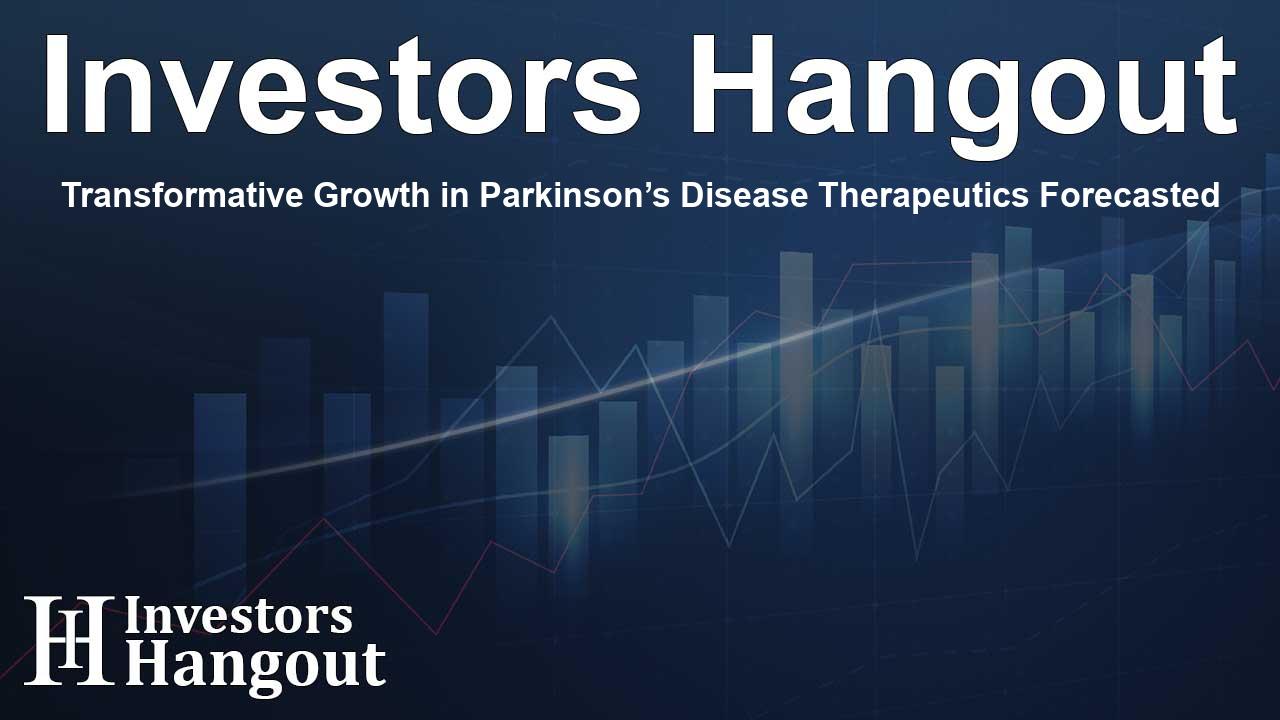Transformative Growth in Parkinson’s Disease Therapeutics Forecasted

Transformative Growth in Parkinson’s Disease Therapeutics
As we navigate the landscape of neurological disorders, the therapeutic domain for Parkinson's disease is poised for remarkable transformation. Recent analyses provide an optimistic outlook for the Parkinson’s disease market, with an expected growth period spanning from 2020 to 2034. The anticipated market expansion is largely driven by the development of innovative therapies, increased access to healthcare, and a continued rise in diagnosis rates.
Understanding Parkinson’s Disease
Parkinson’s disease is characterized by the gradual degeneration of nerve cells within the substantia nigra section of the brain, a process that substantially affects motor control. This neurodegenerative disorder impacts individuals' ability to move smoothly, leading to symptoms such as tremors, rigidity, and bradykinesia (slowness of movement).
Currently, over 3 million people across major markets are diagnosed with Parkinson’s disease, a number that is on the rise. Although there is no outright cure, a combination of pharmacological treatments and rehabilitation therapies plays a crucial role in managing symptoms. Common treatments involve medications such as levodopa, dopamine agonists, and MAO-B inhibitors, aimed at alleviating motor function issues.
The Evolving Treatment Landscape
The treatment pipeline for Parkinson’s disease is notably robust. By 2024, the market for Parkinson’s therapies was estimated to surpass USD 3.5 billion, with expectations for substantial growth over the next decade. Emerging therapies in clinical trials show promise in addressing unmet medical needs and possibly improving quality of life for patients.
Key Therapies and Interventions
Managing Parkinson’s disease often requires a multi-faceted approach. Non-pharmacological therapies like physical and occupational therapy are vital components of patient care. For those experiencing severe symptoms, surgical options may also be considered.
Medications prescribed for Parkinson’s patients include a variety of drugs targeting motor symptoms. Levodopa remains a cornerstone of treatment, but long-term use can lead to complications such as dyskinesia. To mitigate such risks, healthcare professionals are adjusting treatment plans based on individual patient needs.
Parkinson’s Disease Levodopa-Induced Dyskinesia
Levodopa-induced dyskinesia (LID) is a significant concern for many patients. In 2023, the prevalence of diagnosed LID cases was around 597,000 across key regions. Management of LID may involve modifying levodopa dosages and incorporating adjunct therapies like amantadine. Several new treatments in development are anticipated to change the landscape for treating LID patients as they aim to provide more targeted approaches.
Parkinson's Disease Psychosis
Another challenging aspect of Parkinson’s disease is the prevalence of psychosis, which affects cognitive and behavioral health. The 2023 analysis suggested approximately 875,000 people experiencing Parkinson's Disease Psychosis (PDP) in major markets. This involves a range of symptoms, including visual hallucinations and significant psychiatric challenges, necessitating a sensitive and informed treatment plan.
The treatment regimen typically includes antipsychotic medications, with a preference for those that minimize motor function exacerbation. The recent FDA approval of pimavanserin marks a significant advancement but also underscores the complexity of managing these patients due to inherent risks.
Parkinson’s Disease-Related Dementia
As Parkinson’s progresses, some individuals may develop dementia specifically linked to their condition. The prevalence of Parkinson’s disease dementia (PDD) is notably high, especially in older age groups. Currently, the only FDA-approved therapy for PDD is the Exelon Patch, which offers a user-friendly delivery mechanism for patients with cognitive impairments.
The need for enhanced treatment options remains urgent, and a few promising therapies are currently in development. These potential drugs are gearing up to tackle the cognitive decline that impacts many living with Parkinson's disease.
Innovations in Gene Therapy
The landscape of treatments for Parkinson’s disease is continually evolving with the advent of gene therapy and regenerative medicine. These cutting-edge approaches aim to address the root causes of the disease rather than merely mitigating symptoms. Therapies that focus on repairing or replacing damaged neurons hold great promise, but no gene therapy has successfully reached regulatory approval for treating Parkinson's disease yet.
In the coming years, advancements in genetic research, such as understanding mutations linked to Parkinson’s, alongside new treatment modalities, are expected to enhance patient outcomes significantly.
Conclusion
The future of Parkinson’s disease treatment is bright with ongoing innovations and a commitment to improving quality of life for patients. As the market expands through 2034 and beyond, new treatment avenues will undoubtedly emerge, bringing hope and increased functionality to those affected by this complex condition.
Frequently Asked Questions
What is the projected growth for Parkinson’s disease therapies?
The Parkinson’s disease market is anticipated to see significant growth, with estimates suggesting an expansion to over USD 3.5 billion by 2024.
What are the common symptoms of Parkinson’s disease?
Common symptoms include tremors, rigidity, bradykinesia, and issues with balance and coordination.
How is Parkinson’s disease currently treated?
Treatment typically involves a mix of pharmacological therapies, rehabilitation services, and in some cases, surgical interventions.
What is levodopa-induced dyskinesia?
Levodopa-induced dyskinesia is a side effect that can occur with long-term levodopa treatment, leading to involuntary movements that may significantly affect quality of life.
Are there new therapies being developed for Parkinson’s disease?
Yes, numerous promising therapies, including gene and cell therapies, are currently in development and show potential to transform patient care.
About The Author
Contact Addison Perry privately here. Or send an email with ATTN: Addison Perry as the subject to contact@investorshangout.com.
About Investors Hangout
Investors Hangout is a leading online stock forum for financial discussion and learning, offering a wide range of free tools and resources. It draws in traders of all levels, who exchange market knowledge, investigate trading tactics, and keep an eye on industry developments in real time. Featuring financial articles, stock message boards, quotes, charts, company profiles, and live news updates. Through cooperative learning and a wealth of informational resources, it helps users from novices creating their first portfolios to experts honing their techniques. Join Investors Hangout today: https://investorshangout.com/
The content of this article is based on factual, publicly available information and does not represent legal, financial, or investment advice. Investors Hangout does not offer financial advice, and the author is not a licensed financial advisor. Consult a qualified advisor before making any financial or investment decisions based on this article. This article should not be considered advice to purchase, sell, or hold any securities or other investments. If any of the material provided here is inaccurate, please contact us for corrections.
